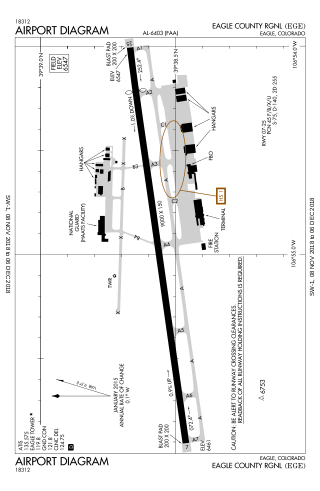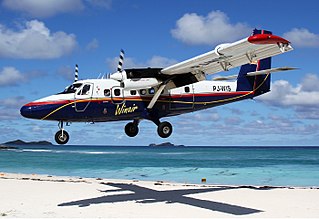Air Wisconsin Airlines is a regional airline based at Appleton International Airport in the town of Greenville, Wisconsin near Appleton, Wisconsin.The company began operations as a United Express partner in 1985. The airline later added flights for US Airways Express before becoming an American Eagle regional carrier after the merger of American Airlines and US Airways. From March 2018 to April 2023, Air Wisconsin exclusively operated as a United Express carrier, with hubs at Chicago–O'Hare International Airport (ORD) and Washington–Dulles. In April 2023, it shifted to operating only for American Eagle. The agreement with American is set to conclude in April 2025, after which the airline plans to transition to only flying charter and Essential Air Service subsidized flights.

Eagle County Regional Airport is a public airport in Gypsum, Colorado, United States. The airport is also sometimes advertised as the Vail/Eagle Airport by airlines and other entities as it is located 4 miles from Eagle and 37 miles from Vail. It covers 632 acres (256 ha) and has one runway. It is primary commercial airport for the Vail and Beaver Creek ski resorts, and as a result service is highly seasonal, with more flights in the winter than the rest of the year.

Telluride Regional Airport is a public airport six miles west of Telluride, in San Miguel County, Colorado, United States. It is owned by the Telluride Regional Airport Authority. At an elevation of 9,078 feet above sea level, it was the highest commercial airport in North America with scheduled passenger flights when Great Lakes Airlines resumed scheduled passenger service in December 2016; however, those flights ceased in March 2018. In August 2018, commercial service returned with the introduction of Boutique Air, and the airport remains the highest airfield in the U.S. with scheduled passenger flights, and the second highest overall airfield in the US behind Leadville Airport. Denver Air Connection is currently the only airline flying scheduled passenger flights from Telluride with daily nonstop flights to Denver and Phoenix. Denver Air operates the Fairchild-Dornier 328JET into Telluride. The 328JET is one of the few regional jet airliners in service capable of operating at such high field elevations as TEX.

The de Havilland Canada DHC-6 Twin Otter is a Canadian STOL utility aircraft developed by de Havilland Canada in the mid-1960s and still in production today. Built by De Havilland Canada from 1965 to 1988, Viking Air purchased the type certificate and restarted production in 2008, before re-adopting the DHC name in 2022. In 2023 DHC restarted production of the 300 series, in addition to the Series 400 produced by Viking.

The de Havilland Canada DHC-7, popularly known as the Dash 7, is a turboprop-powered regional airliner with short take-off and landing (STOL) performance. Variants were built with 50–54 seats. It first flew in 1975 and remained in production until 1988 when the parent company, de Havilland Canada, was purchased by Boeing in 1986 and later sold to Bombardier. In 2006 Bombardier sold the type certificate for the aircraft design to Victoria-based manufacturer Viking Air.
Air BC was a Canadian regional airline headquartered in Richmond, British Columbia, Canada. It later became part of Air Canada Jazz. This regional airline primarily flew turboprop aircraft but also operated jets as well as an Air Canada Connector carrier on behalf of Air Canada via a code share feeder agreement.

Time Air was an airline in Canada founded in 1966 by businessman Walter “Stubb” Ross from Lethbridge in Alberta. It was called Lethbridge Air Service before becoming Time Airways Ltd. in 1969, which was later shortened to Time Air Ltd. In 1993 it was merged with Ontario Express to create Canadian Regional Airlines.

Cheyenne Regional Airport – also known as Jerry Olson Field – is a civil-military airport a mile north of downtown Cheyenne, in Laramie County, Wyoming. It is owned by the Cheyenne Regional Airport Board.

Grand Junction Regional Airport is three miles (4.8 km) northeast of Grand Junction, in Mesa County, Colorado, United States. Owned by the Grand Junction Regional Airport Authority, it is the largest airport in western Colorado and third largest in the state, behind Denver International Airport and Colorado Springs Airport.

Durango–La Plata County Airport is a city- and county-owned public airport 12 miles southeast of Durango, in La Plata County, Colorado.

Gunnison–Crested Butte Regional Airport is a county-owned, public airport one mile southwest of Gunnison, in Gunnison County, Colorado, United States. Also known as Gunnison County Airport, it serves the valley and nearby Crested Butte, Colorado, with airline and general aviation flights.
MarkAir was a regional airline based in Anchorage, Alaska, that became a national air carrier operating passenger jet service in the United States with a hub and corporate headquarters located in Denver, Colorado. After a second bankruptcy in 1995, it ceased operations in October and was later liquidated.
Frontier Airlines was a United States local service carrier, a scheduled airline that was formed by the merger of Arizona Airways, Challenger Airlines, and Monarch Air Lines on June 1, 1950. Headquartered at the now-closed Stapleton International Airport in Denver, Colorado, the airline ceased operations on August 24, 1986. A new airline using the same name was founded eight years later in 1994.
Aspen Airways was an airline carrier and regional affiliate of United Express and based in Hangar 5 in Stapleton International Airport in Denver, Colorado. Aspen ceased operations on April 1, 1990, when separate portions of the airline were acquired by Mesa Airlines and Air Wisconsin Services, Inc.

Sierra Pacific Airlines is an American charter airline based in Tucson, Arizona, United States. It operates passenger charters and sub-charters for other airlines, as well as for the United States Forest Service, United States Military and the United States Marshals Service with jet aircraft. Sierra Pacific also previously operated scheduled passenger service in the western U.S. with prop and turboprop aircraft.
A STOLport or STOLPORT was an airport designed with STOL operations in mind, usually for an aircraft class of a certain weight and size. The term "STOLport" did not appear to be in common usage as of 2008, although was commonly used by pilots flying into Biggin Hill during 1986/87 when the London City Airport was opened restricting approaches and ceilings to the north of Biggin. A STOLport usually has a short single runway, generally shorter than 1,500 m (5,000 ft). STOLports are only practicable by certain types of aircraft, especially smaller propeller aircraft, with performances that are compatible with the shorter runway length, steeper approach/departure paths, etc. at individual STOLports. In the United States, short runway facilities are simply known as airports, and the term "STOLport" has not been commonly used since the early 1970s.

Lake County Airport, also known as Leadville Airport, is a county-owned public-use airport located two nautical miles (3.7 km) southwest of the central business district of Leadville, a city in Lake County, Colorado, United States.

Steamboat Springs Airport is a city-owned airport three miles northwest of Steamboat Springs, in Routt County, Colorado. The National Plan of Integrated Airport Systems for 2011–2015 categorized it as a general aviation facility.

Metro Airlines, originally Houston Metro Airlines, was a commuter airline that was originally headquartered in Houston, Texas, United States. Metro subsequently moved its headquarters to north Texas. The airline had an operational base located on the grounds of Dallas/Fort Worth International Airport and also had offices on the airport property and in Grapevine, Texas. Metro evolved into an airline holding company with the acquisition or creation of a number of different airlines, including as the banner carrier operating feeder services for Eastern Airlines as Eastern Metro Express which was based in Atlanta, GA and Metroflight which operated American Eagle service from the Dallas/Ft. Worth Airport. The company filed for bankruptcy in 1993, and the assets were acquired by AMR Simmons Airlines.

Rocky Mountain Airways Flight 217, referred to in the media as the "Miracle on Buffalo Pass", was a scheduled domestic passenger flight from Steamboat Springs, Colorado to Denver that crashed on Buffalo Pass. The aircraft, a de Havilland Canada DHC-6 Twin Otter 300, impacted terrain on a gentle slope and was partially buried in snow. All of the 22 passengers and crew survived the impact, but a female passenger died before rescue could arrive, and the captain died of his injuries 3 days after the accident. The investigation determined that the accident was caused by the formation of ice on the wings combined with downdrafts associated with a mountain wave led to the aircraft's loss of control and impact with terrain.















